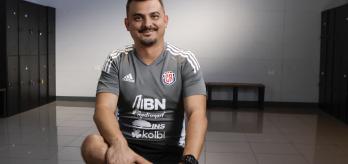Learning
-
The importance of developing long-term strategy and systems that outlast personnel
-
Utilising data and analytics to set achievable strategic goals
-
Ensuring correlation between strategy, objectives, action plans and tasks
Long-term thinking
Long-term thinking and a ‘stable system’ are required for football development strategies to be successful, says Rafael Garibyan, who at the time of the interview held the role of Technical Director of the Kazakhstan Football Federation (KFF).
“We have made our national association strategy for ten years, because in the short-term you cannot make something good in football,” explains Garibyan, who since May of this year has held the role of President of the Professional Football League of Kazakhstan. “We understand that for today, we are not the team that can qualify for a European Championship or a World Cup and we need to make step-by-step improvements.”
Garibyan, who has also worked as a sporting director and general director in club football, explains that to achieve Kazakhstan’s long-term aim of qualifying for a major tournament, work must be done in developing the football strategy across the country and at all levels of the game.
“The biggest challenge for now is to make the right concept for the whole technical department: grassroots, national teams, technical centre, leagues and education. And we need to make the whole concept of football development in the country in the right way.
“I spend around 20% of my time on each area otherwise something will be missed,” adds Garibyan. “Because we are at the starting point with all of this work, it all depends on the people who work inside. In some areas, the experience of the people involved is what we need, so we don't need a lot of time to manage them. However, in another area you need to spend more time. At the moment this process is very complicated and needs to be arranged a little more precisely.”
Stable systems
In order for the football development strategy to be a success, Garibyan talks about developing ‘stable systems’ that will outlast senior personnel.
“The system of football development needs to be independent of any change,” says Garibyan, who studied at London’s Birkbeck University. “Sometimes, the general secretaries are changing, the presidents are changing, even the technical director is changing, but the system of football development should be stable - particularly in a developing country like ours.
“There may be better people who come into the federation and are involved, but the system should be stable,” he adds. “Otherwise, you will never have a good result. If you are training and working on something today and, the next day, you are training and working in a completely different way, nothing will happen.”
Developing a ‘precise’ strategy: objectives, action plan and tasks
Developing an achievable football development strategy, with clear accountabilities and success measures, is important to Garibyan, who emphasises the importance of being ‘precise’.
“If you set out the wrong goal, objectives and aims it’s like running for ten years but doing nothing - it’s very important to set out achievable goals that are right for the kind of football development we want. That’s why we are very precise to the strategy and linking that to action plans and tasks.”
Data and analytics also play a key part in helping to create and measure objectives, says Garibyan. “We are analysing everything in terms of numbers,” explains Garibyan. “We are analysing the number of people involved in football, the number of facilities, the number of coaches, the resources involved in football and the finance.
“For every aspect of the strategy, we are analysing and we are looking for this correlation between every aspect. After that, we are taking decisions because many parts are connected to each other and sometimes you use the same resources for the same things.”
One clear objective for the KFF is to widen the playing pool, says Garibyan. “Football development is a must,” he says. “If you have a lot of players to choose from it is easier to choose the best ones. In other developed countries, football is like a religion and there are a lot of players playing, including women’s football.”
Although Garibyan acknowledges the benefits of comparison with other countries, he knows that Kazakhstan’s evolving strategy must be specific to their own unique national characteristics. “Firstly, we need to understand what kind of people and players we have in terms of playing capabilities. After that, we need to adjust the style accordingly. So, we cannot just say we want to play the English style or Spanish style. We need to make a clear decision in terms of the data we have collected.”
Summary
-
Develop long-term strategy and systems that outlast changes in personnel
-
Use data and analytics to help outline achievable goals and objectives
-
Ensure alignment across strategy, objectives, action plans and tasks
Reflection
-
How long-term is your strategy?
-
How can you ensure that your strategy and systems will outlast changes to key personnel?
-
What role do data and analytics play in creating and measuring objectives in your strategy?











